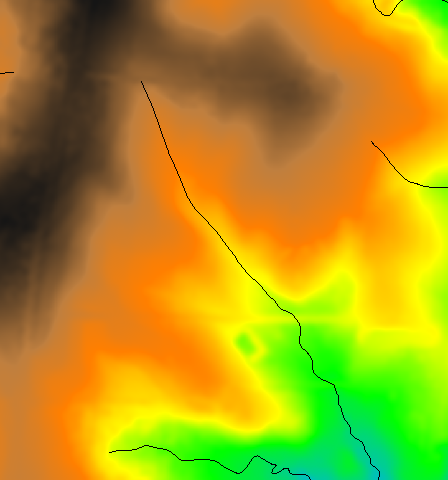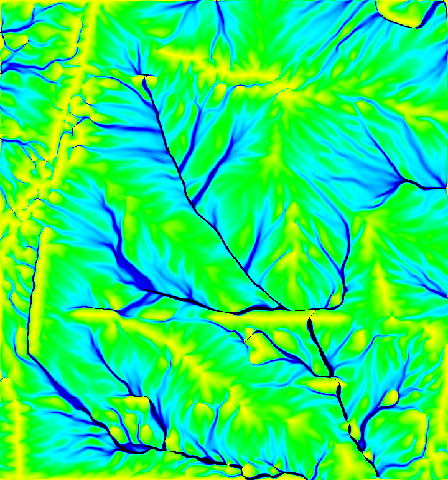
NAME
r.carve - Generates stream channels.Takes vector stream data, transforms it to raster and subtracts depth from the output DEM.
KEYWORDS
raster, hydrologySYNOPSIS
r.carve
r.carve --helpr.carve [-n] raster=name vector=name output=name [points=name] [width=float] [depth=float] [--overwrite] [--help] [--verbose] [--quiet] [--ui]
Flags:
- -n
- No flat areas allowed in flow direction
- --overwrite
- Allow output files to overwrite existing files
- --help
- Print usage summary
- --verbose
- Verbose module output
- --quiet
- Quiet module output
- --ui
- Force launching GUI dialog
Parameters:
- raster=name [required]
- Name of input raster elevation map
- vector=name [required]
- Name of input vector map containing stream(s)
- Or data source for direct OGR access
- output=name [required]
- Name for output raster map
- points=name
- Name for output vector map for adjusted stream points
- width=float
- Stream width (in meters)
- Default is raster cell width
- depth=float
- Additional stream depth (in meters)
Table of contents
DESCRIPTION
r.carve accepts vector stream data as input, transforms them to raster, and subtracts a default-depth + additional-depth from a DEM. If the given width is more than 1 cell, it will carve the stream with the given width. With the -n flag it should eliminate all flat cells within the stream, so when and if the water gets into the stream it will flow. The points option generates x,y,z for points which define the stream with the z-value of the bottom of the carved-in stream. These points can then be combined with contours to interpolate a new DEM with better representation of valleys.NOTES
r.carve does not create a depressionless DEM because many depressions are in flat areas and not in the streams.EXAMPLE
North Carolina sample dataset:# set computational region g.region raster=elev_lid792_1m -p # digitize a ditch for the farm pond echo "L 3 1 638692.93595422 220198.90026383 638737.42270627 220149.74706926 638984.43306379 220148.19158842 1 1" | v.in.ascii -n input=- output=ditch format=standard # visualize original data d.mon wx0 d.rast elev_lid792_1m d.vect ditch # carve r.carve raster=elev_lid792_1m vector=ditch output=carved_dem width=3 depth=0.5 # visualize resulting carved DEM map d.rast carved_dem # visualize r.relief input=elev_lid792_1m output=elev_lid792_1m_shaded r.relief input=carved_dem output=carved_dem_shaded d.rast elev_lid792_1m_shaded d.erase d.rast carved_dem_shaded # flow accumulation r.watershed elevation=elev_lid792_1m accumulation=elev_lid792_1m_accum r.watershed elevation=carved_dem accumulation=carved_dem_accum d.rast elev_lid792_1m_accum d.erase d.rast carved_dem_accum # differences r.mapcalc "accum_diff = elev_lid792_1m_accum - carved_dem_accum" r.colors accum_diff color=differences d.erase d.rast accum_diff
KNOWN ISSUES
The module does not operate yet in latitude-longitude coordinate reference system. It has not been thoroughly tested, so not all options may work properly - but this was the intention.REFERENCES
Terrain modeling and Soil Erosion Simulations for Fort Hood and Fort Polk test areas, by Helena Mitasova, Lubos Mitas, William M. Brown, Douglas M. Johnston, GMSL (Report for CERL 1999)SEE ALSO
r.flow, r.fill.dir, r.watershedAUTHORS
Bill Brown (GMSL)GRASS 6 update: Brad Douglas
SOURCE CODE
Available at: r.carve source code (history)
Latest change: Tuesday Dec 17 20:17:20 2024 in commit: d962e90c026708a4815ea2b9f46c0e84c17de22d
Main index | Raster index | Topics index | Keywords index | Graphical index | Full index
© 2003-2025 GRASS Development Team, GRASS GIS 8.4.3dev Reference Manual





